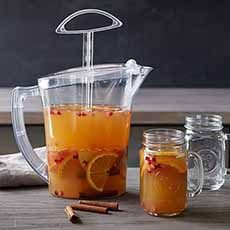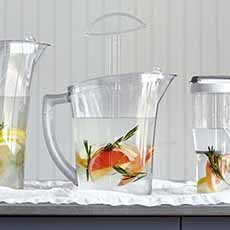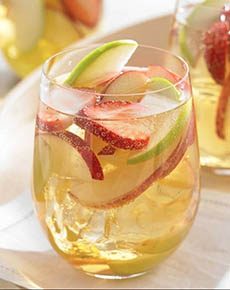TIP OF THE DAY: Apple Cider Sangria Recipe
|
Fall means apple cider, a drink that’s refreshing served cold or hot (mulled cider). Here’s a festive drink that adds wine, to make it a sangria. Here’s how to set up an apple cider bar for a party. If you need a pitcher, take a look at Pampered Chef’s Quick-Stir Pitcher. It has a plunger feature, to make it easy to mix powdered drinks, and can be used to serve hot or cold drinks. Bonus: The sleek design fits into your refrigerator door. Here’s more about it. You can also serve the sangria from a punch bowl. This drink is made with what Americans call apple cider, but in Europe, apple cider is an alcoholic drink. Thanks to Pampered Chef for the recipe. For a non-alcoholic version, substitute 3 cups (750 mL) lemon or orange sparkling water for the wine. Ingredients For 8 Servings 1. PLACE the cinnamon sticks, 1 cup of the apple cider and the honey in 2-cup prep bowl. Microwave, uncovered, on HIGH 2 minutes. Carefully remove the bowl from the microwave. 2. POUR the cinnamon sticks and cider into a pitcher. Place in the refrigerator until ready to combine. 3. CUT the apple and orange in half lengthwise, and then into slices. Add all of the fruit, the remaining apple cider and and wine into the pitcher; stir. 4. PLACE the lid on the pitcher, or cover with plastic wrap. Chill for several hours or overnight. 5. TO SERVE: Pour the sangria into glasses with ice. Top with some of the fruit, if desired. Nutrients per 8-ounce serving: Calories 140, Total Fat 0 g, Saturated Fat 0 g, Cholesterol 0 mg, Sodium 0 mg, Carbohydrate 21 g, Fiber 1 g, Sugars 6 g, Protein 0 g. |
|
|
|
Wild apple trees originated in the mountains of Central Asia. The center of diversity of the genus became eastern [present-day] Turkey. The apple tree may have been the earliest tree that humans cultivated. Over the millennia, through selective breeding, farmers improved the fruits [source]. When the Romans invaded England around 55 B.C.E., they found the locals cultivating apple orchards and drinking apple cider. The original apple varieties weren’t for eating. They were bitter, so were pressed for their juice and left to ferment into alcohol. The Romans immediately embraced the drink, and cider quickly spread through the Roman Empire and across Europe: from the Germanic tribes to the east, to the Normans in the south (northern France). When the Normans invaded England in the 9th century, they returned to Normandy with the rootstock to grow their own apple orchards and left behind the word “cider” for the English language [source]. Everyone drank cider or beer: adults and children alike. Due to unhealthy water sources, it was the safer choice. Fast forward: Colonists brought apples to North America in the 17th century—the bitter cider apples. Apples were being grown in Massachusetts as early as 1630. At the end of the 18th century, Johnny Appleseed traveled west to spread apple trees for cider. As in Europe, cider or beer was drunk instead of water. Mutation was continually creating new breeds of apples. The McIntosh mutation was discovered in 1796, by a farmer named John McIntosh. It was sweeter, and was best for eating rather than fermenting. More sweet mutations followed, and today, we have as many varieties of sweet apples as cider apples.
|
||






